 Next: Other figures
Next: Other figures
 Next: Other figures
Next: Other figures
There exists an interesting nonsmooth codimension-2 bifurcation point
in the plane  = 0. This point
can be seen in Figure 11 (left) and in
the enlargements in Figure 13 as the point where
the region with unbounded SNAs (blue) and the bistable region (yellow)
touch. It is characterized as the moment where two nonsmooth
(supercritical) pitchfork bifurcations happen simultaneously.
= 0. This point
can be seen in Figure 11 (left) and in
the enlargements in Figure 13 as the point where
the region with unbounded SNAs (blue) and the bistable region (yellow)
touch. It is characterized as the moment where two nonsmooth
(supercritical) pitchfork bifurcations happen simultaneously.

Figure 13:
Successive magnifications of Figure 11
(left). The white region corresponds to pairs of invariant curves,
regardless of their phase sensitivity.
In the smooth analog of this nonsmooth codimension-2 bifurcation point two supercritical pitchfork bifurcations that occur in the order as shown in Figure 14 (left), change order without changing from supercritical to subcritical. As shown in Figure 14 (right), this means that we necessarily need extra curves of saddle-node bifurcations.
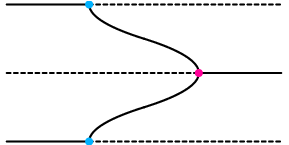
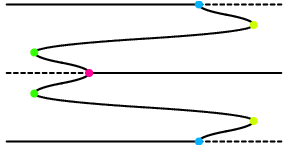
Figure 14:
Two different bifurcation diagrams along the line  = 0 that both involve two
(smooth) supercritical pitchfork bifurcations. Shown are invariant
curves (represented by one point) versus
= 0 that both involve two
(smooth) supercritical pitchfork bifurcations. Shown are invariant
curves (represented by one point) versus  with K fixed. If the pitchfork bifurcation
creating two attractors does not happen first, we necessarily need
extra curves of saddle-node bifurcations (right).
with K fixed. If the pitchfork bifurcation
creating two attractors does not happen first, we necessarily need
extra curves of saddle-node bifurcations (right).
 ,
K)-plane the complete bifurcation diagram should look like Figure 15.
,
K)-plane the complete bifurcation diagram should look like Figure 15.
The bifurcation sequence in region I in Figure 15 is as in Figure 14 (left). We enter other regions by crossing bifurcation curves. The sequence of bifurcations in regions II-IV is shown in Figure 16. Finally, in region V we get the bifurcation sequence of Figure 14 (right).
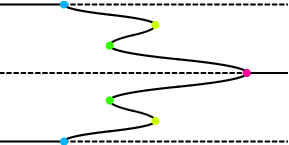
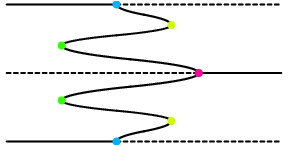
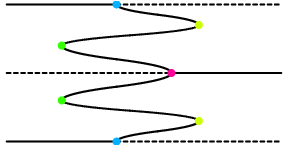
Figure 16:
Qualitative bifurcation diagrams for K-values in the
K-intervals II (left), III (middle), and IV (right) in Figure 15. The equivalent diagrams for the
K-intervals I and V are shown in Figure 14.
The unfolding of the nonsmooth codimension-2 bifurcation point is surprisingly simple in contrast; see Figure 17. All curves are now nonsmooth bifurcations and the qualitative behavior in three of the four regions is depicted in Figure 18.
 Next: Other figures
Next: Other figures
Created by Hinke Osinga
Last modified: Wed May 17 16:11:09 2000